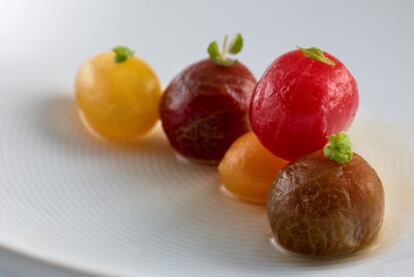A chance to chew over new ideas
The year 2012 is set to be one full of gastronomic developments, from the rise of Korean and Latino cuisine, to a passion for preserves and innovative tapas
Many of the gastronomic tendencies of 2011 will be running through onto this year's menu: tapas as a serious alternative to full dishes, a passion for vegetables, an increase in organic wine production, the fusion of cuisines and the breakthrough of Latino cooking. Last year saw plenty of restaurants close down, but in the wake of the crisis, the few that have opened are aspiring to slice and dice against the current.
-Pop-up restaurants. In order to compete with the fast-food vans that now crowd our streets, the pop-up restaurant was born. Chefs who have tried this kind of temporary venture include the daring, emerging kind, as well as the mega-famous, such as US-born Thomas Keller (French Laundry), who took the formula to London's Harrods for a time. One of the most promising names in Spain's young and avant-garde culinary world, Paco Morales, has joined forces with some architects from Valencia to start a moveable, multidisciplinary "cirque du soleil of tapas."
- Sabbaticals. Just as world-famous Catalan restaurant elBulli would take a few months off each year (it is currently on sabbatical until at least 2014), Andoni Luis Aduriz and his team are taking a short sabbatical until spring to think about more than just food. Other Spanish chefs opting for a brief period of reflection include Dani García and Quique Dacosta. Some take a bit longer for their sabbaticals. The great Chicago chef Charlie Trotter has announced he will be closing his famous restaurant - after 25 years and two Michelin stars - to dedicate his time "to travel and study;" although Trotter's To Go, the take-away restaurant, will remain open.
- The Korean hour. A new Asian dragon to compete with Chinese and Japanese cuisine: the power of kimchi has arrived. With a diet full of vegetables and healthy recipes, where soya and fermented beans reign supreme, the Republic of Korea is taking root in Europe, with the help of chef Sang Hoon Degeimbre, who will be presenting at the 10th edition of the Madrid Fusión culinary summit later in January.
- Latino revolution. Peruvians, Mexicans, Brazilians, Venezuelans and Ecuadorians... All kinds of Latino tastes are winning over the Spanish palate. In Madrid there are endless new openings, while chefs such as Dani García are opening restaurants in North America and Sergi Arola and Javier and Sergio Torres are opening up in South America.
- Organic wines. More and more wine cellars are investing in organic production: no additives or pesticides here. At the end of January, the French city of Montpellier will be hosting Millésime Bio, an international organic farming wine fair.
- Chinese shots. While the Japanese are battling to bring in quality sake to Spain, the Chinese are bottling their own wines in an attempt to flood the market. Western vines have been sown into Eastern soil, and the work of both foreign and native winemakers will soon see their products arriving in Spanish glasses.
- More greens. The new vegetarianism is spreading its roots. Devotees of raw produce will be less of an exception, while more and more chefs will be spending time working on their vegetable patches. Vegetables are even being grown on the roofs of restaurant buildings, while in the United Kingdom and the United States some chefs are turning their hands to the art of beekeeping.
- Eating with your fingers. Another sign of tight-times: dinner guests eating elbow to elbow, thus saving space and money. Sharing tables has long been the preserve of traditional taverns, but the practice is becoming ever more popular in modern eateries. There's a growing trend of restaurants featuring bars where diners can sit and watch their meals being prepared, while an increasing number of chefs are offering bite-sized snacks that are to be eaten without the aid of cutlery.
- Virtual/real communities. A new phenomenon among foodies is groups that get together to buy produce in bulk to save money. Such an approach also foments friendships and neighborly interaction. Another trend stems from cooking blogs, written by amateur chefs and enthusiasts. From this online contact stem plenty of organized, in-home dinners - another money-saving option. Another growing trend, albeit less ecological, is the proliferation of smokers clubs, a consequence of the year-old legislation that bans the habit in public spaces.
- Kicking the can. Another sign of the times of crisis in which we live is the use of canned and preserved products, such as fish, vegetables and broths. Prices vary, as a result of seasonal offerings and luxury brands. Star chefs use them too, coming up with imaginative recipes.
- Plenty of pasta. Rice, noodles, macaroni and legumes abound, both on family dinner tables and in a range of restaurants. Gaining ground on popular trattorias , Chinese and Japanese noodle bars are on the rise. Look out for udon and ramen, both types of hot Japanese noodle soup.
- Upscale markets. While neighborhood stores are doing their best to survive by offering competitive prices and attractions for city-dwellers, more upscale markets, where visitors can buy produce to take home or eat and drink there, are set to open in 2012.
- Ice-cream and mini-pastries. Ice-cream's gastronomic reputation has been elevated even further thanks to prominent professionals creating some inventive concoctions. What's more, selections of mini-desserts will become an ever-more common sight.


Tu suscripción se está usando en otro dispositivo
¿Quieres añadir otro usuario a tu suscripción?
Si continúas leyendo en este dispositivo, no se podrá leer en el otro.
FlechaTu suscripción se está usando en otro dispositivo y solo puedes acceder a EL PAÍS desde un dispositivo a la vez.
Si quieres compartir tu cuenta, cambia tu suscripción a la modalidad Premium, así podrás añadir otro usuario. Cada uno accederá con su propia cuenta de email, lo que os permitirá personalizar vuestra experiencia en EL PAÍS.
¿Tienes una suscripción de empresa? Accede aquí para contratar más cuentas.
En el caso de no saber quién está usando tu cuenta, te recomendamos cambiar tu contraseña aquí.
Si decides continuar compartiendo tu cuenta, este mensaje se mostrará en tu dispositivo y en el de la otra persona que está usando tu cuenta de forma indefinida, afectando a tu experiencia de lectura. Puedes consultar aquí los términos y condiciones de la suscripción digital.








































